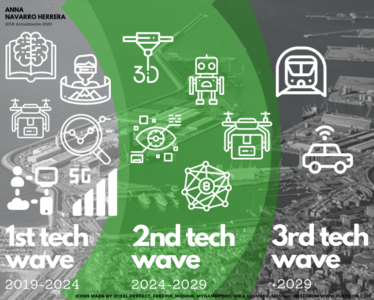IPCSA Emerging Technologies Study
Emerging Technologies and PCS Vision of the Future
IPCSA is analysing how Emerging Technologies and the future vision of PCS will combine to create the next generation of electronic exchange platforms. Currently IPCSA is undertaking a survey as detailed below.
The arrival of emerging technologies in ports will transform them just as they will transform the supply chain and the production industry. As emerging technologies mature, they will become more relevant in ports, making this transformation happen progressively. But in 10 years, what technologies are we going to see in ports?
In a study carried out in 2018 on emerging technologies in ports (Navarro-Herrera 2018), twelve 4.0 technologies were analysed that could be relevant in the future of ports; Internet of Things, Drones, Big Data, Machine Learning, Virtual Reality, Augmented Reality, 3D Printing, Robots, 5G, Blockchain, Hyperloop and Autonomous Vehicles. The study of these technologies identified that there are going to be three technology waves in which these technologies are going to reach the ports in a widespread way. Based on data from Gartner’s hype cycles for emerging technologies, Drones, Big Data, Internet of Things, Virtual Reality and 5G are expected to reach maturity between 2019-2024 and 3D printing, intelligent robots, augmented reality, Blockchain and drones for light cargo delivery between 2024-2029. Beyond 2029, level 4 and 5 autonomous land vehicles and Hyperloop will begin to be seen.

With these data we can say that in 10 years, 10 of the 12 emerging technologies mentioned are estimated to be mature enough to play a relevant role in ports. But which ones will be present in this port of the future 2030? To answer this question, the study (Navarro-Herrera 2018) is carrying out a survey, with the support of IPCSA, among 25 international experts from Port Community Systems. The results of the survey show that more than 50% of the experts answered that Internet of Things (IoT), Big Data, Autonomous Vehicles (AV), Blockchain, 5G and Drones would be technologies that would be present in the ports of the future.
Based on these data, the study (Navarro-Herrera 2018) concludes that the ports of the future will combine the use of these 6 technologies. Therefore, it will not be a single technology that will define how the ports will be in 10 years, but it will be the combination of these technologies. We will have a physical level of technologies with the Internet of Things, the Autonomous Vehicles and the Drones, generating large volumes of data and bringing automation to the operations. Additionally, we will have a level of connectivity with 5G technology that will be key to perform all data exchange between devices and systems. Finally, the logical level of technologies that provide security, intelligence and management capacity of large volumes of data such as Blockchain and Big Data.
 To conclude, based on the above, we can say that the ports in 2030 will be digital ports thanks to the progressive incorporation of 4.0 technologies. Internet of Things, Autonomous Vehicles, Drones, 5G, Blockchain and Big Data will define the ports as they will be 10 years from now. However, it will be the ports that, based on the opportunities offered by these emerging technologies, will have to adapt to the new digital realities of the world in which they operate, creating new business models and incorporating new ways of operating and new services to offer. Some final reflections, are drones and hyperloops opportunities or threats for ports? How will 3D printing affect ports? Also, opportunity or threat?
To conclude, based on the above, we can say that the ports in 2030 will be digital ports thanks to the progressive incorporation of 4.0 technologies. Internet of Things, Autonomous Vehicles, Drones, 5G, Blockchain and Big Data will define the ports as they will be 10 years from now. However, it will be the ports that, based on the opportunities offered by these emerging technologies, will have to adapt to the new digital realities of the world in which they operate, creating new business models and incorporating new ways of operating and new services to offer. Some final reflections, are drones and hyperloops opportunities or threats for ports? How will 3D printing affect ports? Also, opportunity or threat?
Author
Anna Navarro-Herrera, Telecom Engineer, MSc in IT management
Bibliography
Navarro-Herrera, Anna. 2018. Estudio para identificar las tecnologias emergentes que definiran los Puertos 4.0. Ingeniería y Arquitectura la Salle, Universidad Ramon Llull: Trabajo final de máster.
If you wish to learn more about the survey and our White Paper, please contact Inga Morton, General Manager, IPCSA.







